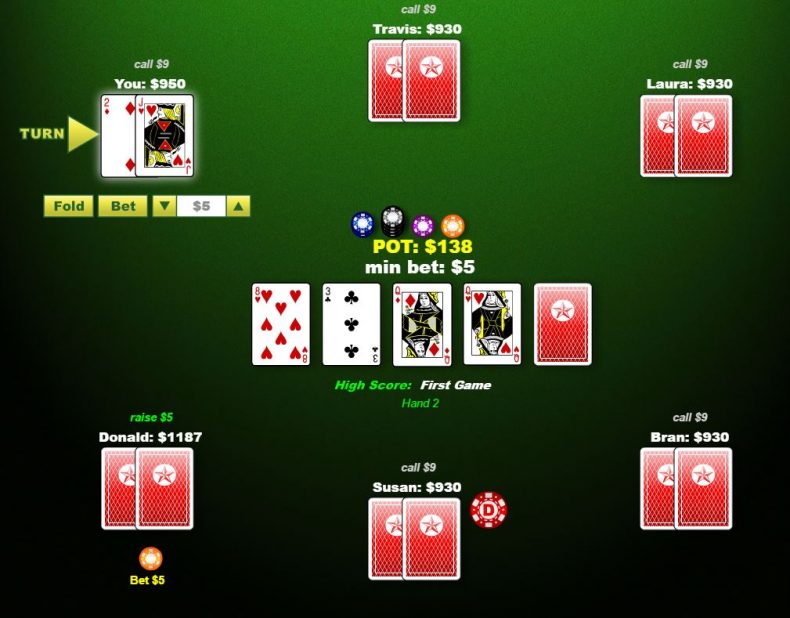Texas Hold Em Facts
Foldand Then Fold Some More. It’s often said that folding is the best play in poker. And this is one. Fact 1 Texas holdem is played with a deck of 52 playing cards, consisting of the same four suits, and 13 ranks in every deck. You know each deck has an ace of spades, and ace of hearts, an ace of clubs, and an ace of diamonds. The same is true for kings, queens, and all of the ranks down through twos. Texas Facts Texas is the second largest U.S. State and the largest southern state. Its landscape includes deserts, cave systems, mountains, canyons, forests, and the Rio Grande, a river that forms the border between Texas and Mexico. Texas is known for its Spanish influence, museums, scenic attractions, and cowboy culture. Quick Facts Capital: Austin Population. Texas Hold 'Em Poker Strategy Tips Two Things to Always Remember. It may seem silly to be reminded of the following fundamental facts, but it's surprising. Evaluating Your Cards. Usually, the first decision you make in a hand of Texas Hold 'Em Poker happens with your only. Play Good Cards and You Will Win. My #1 Texas Holdem tip is one of the very first lessons in poker.
- Texas Hold'em Facts Rules
- Texas Hold'em Facts Game
- Texas Holdem Facts
- Texas Holdem Facts
- Texas Hold'em Facts Games
kidzsearch.com >wiki Explore:webimagesvideosgames
Texas hold'em is a popularversion of the cardgamepoker.
- 2Styles of play
- 2.1Limit
- 2.4No Limit
How to play
Before any cards are dealt, two players to the left of the dealer make bets which are called the 'Small Blind' and 'Big Blind'. These forced bets must be at least matched by the other players in order to keep their hands. The big blind is twice as much as the small blind. If the big blind was $1000, then it is said that the blinds are 500 and 1000. This money is put into a place in the center of the table that is called the 'pot'
Each player is given two cards face down. These are called the player's 'Hole Cards' or what the player has 'in the hole'. Once all the players have their hole cards, the betting starts. The player to the left of the Big Blind player starts the betting. The lowest amount that can be bet is the amount of the big blind. Players can bet more than the minimum. This is called 'Raising'. The amount a player can raise is determined by the type of the game being played (see below) If a player raises, the amount he raised the bet to is the new minimum. Each player in turn may either 'Call' (pay the current bet amount), Raise, or 'Fold' (quit the hand). This action keeps going around the table until each player has called or folded his hand.
Texas Hold'em Facts Rules
After the first turn of betting is over, the dealer lays three cards face up on the table. This is called the 'Flop'. These three cards are 'community cards'. This means they are used by every player in the game along with the two hole cards each player has. After the flop, another turn of betting takes place. There is no starting bet in this turn (no blinds) unless a player makes a bet. Players may 'Check' or bet nothing if no player before them in the turn has bet. If everyone checks, or if a player bets and all the others call or fold, then the round of betting is over.
Next the dealer lays another community card face up. This card is called 'the turn' (or 4th Street). Another series of betting comes after this. This betting is the same as after the Flop.
Finally the dealer lays the last community card known as 'the river' (or 5th Street). This card is again followed by a turn of betting, calling and folding by the players.
With the five community cards and their two hole cards, each player makes the best 5 card poker hand he can. The player with the best poker hand wins the round and the pot. If two or more players have the same hand, those players split the pot evenly. If one person bets and all other players have folded, the hand ends then and that player wins.
Styles of play
Texas Hold'em can be played several ways, including Limit, Pot Limit and No Limit games. The version of the game usually is the maximum a player can raise at any one time.
Limit
Limit games have a set amount that a player can raise at any time. If a game has a $10 limit, then a raise must be exactly $10. If more than one person raises, each one can only raise $10 more than the last raise. Typically, there is a 'cap' of 3 raises per round. Also, when playing limit, the bet and raise amount will usually double for the turn and river betting rounds.
Example
In a 4 player game, Player A bets $10. Player B raises $10 (puts in $20 total), Player C calls Player B (puts in $20). Player D at this point can either fold, pay $20 (call player B) or raise $10 to a total of $30. Player A would go next and either call (paying the difference between his $10 bet and the current bet). This would continue until all players either call or fold.
Pot Limit
In Pot Limit games, the most a player can bet or raise is the total amount in the pot. With each bet or raise, the amount in the pot gets larger. This allows for larger raises.
Spread Limit
In Spread Limit games, there is both a minimum and a maximum raise specified. For example, one could play $5–50 spread limit. The big blind would be $5 and the minimum raise would be $5 and the maximum raise would be $50.
No Limit
In No Limit, there is not a limit of how much can be bet at any time. That is, it is just like Spread Limit, but with no maximum. A player can bet up to all money as he has. If a player bets all of his money, he is said to be 'All In'. If a player bets more money than another player has, the second player can call by going All In. If only those two players stay in the hand (all other players fold), the first player takes back any money that is over the amount the player going All In has. At this point, all betting stops and the dealer deals out the rest of the cards.
If a player goes All In and two or more players are still betting, the other betters can raise each other until they both call (or one of them also goes All In). A 'side pot' is made in this case. It is the difference between the final bet and the first person's All In. Only the two players were not All In can win this pot. If the All In player wins the hand, he wins the main pot (his money plus an equal amount from each other player) and which ever of the other two players had the better hand wins the side pot. In an eight player game, it is possible to have several side pots with several people being All In at the same time. If there are not two player left who can bet, betting stops and all players turn their hands over.
Example
Texas Hold'em Facts Game
Player A bets $5000. Player B only has $3000. He goes All In. Player C Raises $2000 (puts in a total of $7000). Player A calls (puts in $2000). At this point, the main pot is worth $9000 ($3000 from each player). The side pot is worth $8000 ($7000–3000 from Players A and C)

Texas Holdem Facts
If player A or C wins, he wins both the main pot and the side pot ($17,000) and Player B is out of the game since he is out of money. If player B wins, he wins the main pot and the side pot goes to which ever player has the best hand between players A and C.
Tournaments

Tournaments are what people often see when poker is shown on television. When a player enters a tournament, he pays an entry fee called the 'buy-in.' Most of his buy-in is placed with other player's money in the prize pool. Usually, a small portion of the buy-in is kept by the tournament officials for their expenses (and profit). The player is given a table and seat assignment, and a certain number of chips - the same amount as every other player. Unlike normal chips, these tournament chips have no cash value (though they often are referred to with dollar amounts). Players must continue to play until they run out of chips. The tournament continues until one player has accumulated all of the chips. The order in which people lose all their chips (or 'bust out'), is their finishing order. That is, the last player to bust out is the second-place finisher. The prize pool is divided amongst a fraction of the top finishers (usually about 10%). The first-place winner usually gets a much larger share, with the prizes diminishing until the prize pool is empty. The player who was the last player to finish without winning any prize is said to have finished 'on the bubble.'
As players bust out of the tournament, the average player's chip stack gets larger. In order to insure that the blinds do not become insignificant in the face of the growth in chip stacks, tournaments are played in timed 'rounds.' At the beginning of each round typically the blinds increase. Every few rounds there will be a short break between rounds. For tournaments that last longer than a day, there will be a last level for the day, and the tournament will resume the next day.
Most tournaments only allow a player to buy-in and receive chips once, at the beginning. These are called 'freeze out' tournaments. Some tournaments allow players to buy-in more than once for the first few levels of the tournament. These players are said to 're-buy' and the money they use to re-buy goes into the prize pool with the rest of the buy-ins.
Other websites
- Poker Hand - Poker hands listfa:تگزاس هولد ام
There are quite a few poker variations out there, but Texas Hold’em poker is one of the more popular ones to play, especially in high-stakes tournaments and casinos. In fact, when we say poker, we’re usually referring to Texas Hold’em poker specifically, or the lesser-played five-card stud. Despite this, many versions follow the same hand values as Texas Hold’em poker.
Why are hand strengths important to know? Well, if you’re new to the game, it’s vital you memorize the order of hands so you know when to bet. Hand strength dictates your probability of winning, even when you have no hand at all. Let’s take a look at the hand strengths for Texas hold’em poker from best to worst!
Royal Flush
This hand is so rare you probably will never see it in person. In fact, your chance of getting a royal flush in any given hand is .00001%. Why’s it so rare? It’s the highest cards: A, K, Q, J, 10 in any of the four suits, meaning there are only four ways to get it. It’s also the best hand in poker, so if you are one of the lucky few, you’re going to win the round.
Straight Flush
The straight flush is like a royal flush, but with any other five cards in sequential order and the same suit. A good example would be K, Q, J, 10, 9 in any of the same suit. Remember that the higher the combination of cards, the better the hand is.
Four of a Kind
This hand is what it sounds like: four of the same card. Also very rare because you would need all four cards in the deck. Think four 10s, four Jacks, and so on.
Full House
Here’s where the hands start to get more common. A full house is 2 of one kind (any suit) and 3 of another (any suit). So a combination would be 2 5’s and 3 Aces. The higher the combination, the better the full house is. Full Houses are ranked by their triplet pairs first, then their doubles. If they just differ in suit, then they are equally ranked.
Flush
A flush is five cards in any numerical order, but they all have the same suit. So five cards that are diamond, or five that are hearts. It doesn’t count if you only have four, so be careful not to risk too much if you’re missing a card for a flush.
Straight
Right below a flush is a straight. These are cards in sequential order, but not the same suit. 2,3,4,5,6 (6-high) is the lowest form of straight, so that hand would lose to a 3,4,5,6,7 (7-high) straight.
Three of a Kind
This one is pretty straightforward: three of the same number. J, J, J, etc. They do not have to be the same suit (and can’t be unless you use multiple decks).
Texas Holdem Facts
Two Pair
A two pair is two sets of the same numbers. J, J, 10, 10 is a good example. This is a really common type of hand, as the probability to get it is fairly good. The numbers don’t have to match suits.
Pair
This is the second lowest hand: two of the same number. A, A is the highest pair you can have.
High Card

When all else fails, the highest card wins. Even if you don’t have a great hand, your high card is important, and has decided many matches. Your high card is ALWAYS in play, so even if you have a great hand, remember that if someone matches your hand strength, the high card will decide the winner. Keep this in mind, because it happens a lot.
Now that you know the basic hand strengths in Texas Hold’em poker, you’re ready to start playing! Try playing without betting first so you get a feel for the game without the pressure of tossing chips away. Good luck! See more how-tos over at our blog!